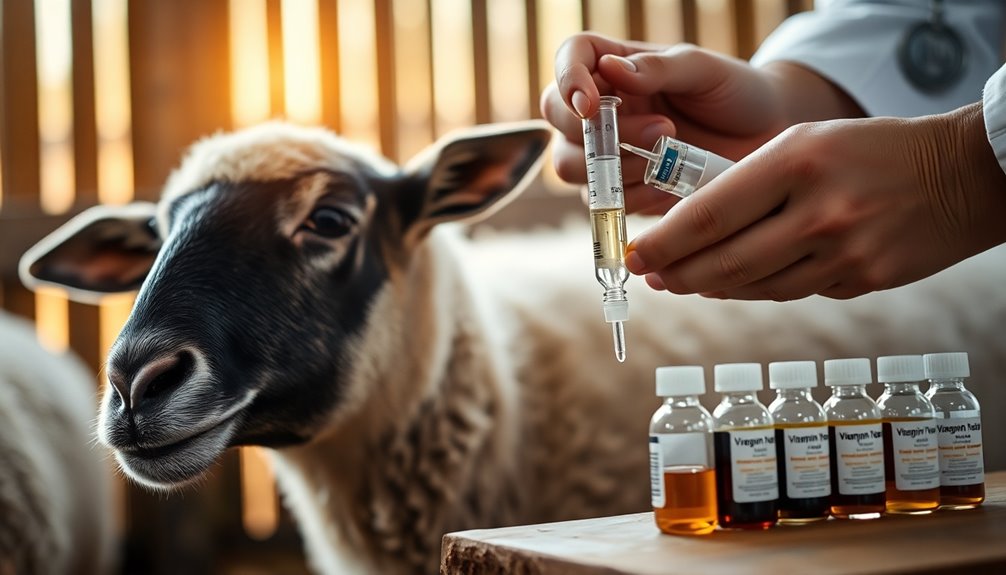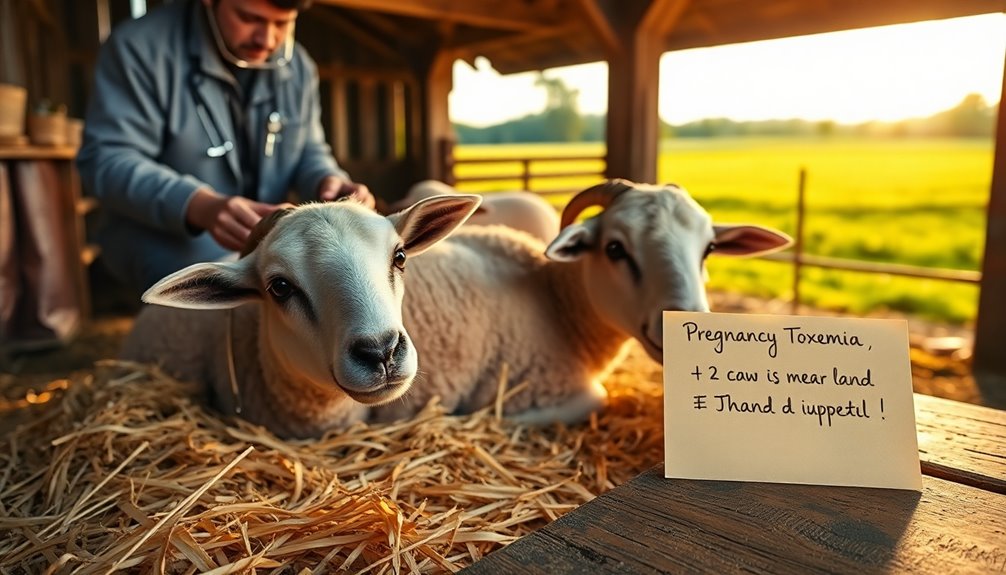Pregnancy toxemia, also known as preeclampsia, is a serious condition that develops after the 20th week of pregnancy, featuring high blood pressure and protein in your urine. You may experience severe headaches, sudden swelling, and visual disturbances. Treatment usually involves delivering the baby, as that's the only cure. Mild cases might be managed with medications and bed rest. Understanding the signs and risks is essential, and there's more to uncover about its management and prevention.
Key Takeaways
- Pregnancy toxemia, or preeclampsia, is a serious condition characterized by high blood pressure and protein in urine after the 20th week of pregnancy.
- Common symptoms include severe headaches, sudden swelling, visual disturbances, and significant weight gain due to fluid retention.
- Early diagnosis involves monitoring blood pressure and urine protein levels during routine prenatal visits.
- Treatment primarily involves delivering the baby; mild cases may require bed rest and blood pressure medications.
- Complications can include eclampsia and HELLP syndrome, making timely medical intervention crucial for maternal and fetal health.
What Is Pregnancy Toxemia?

Pregnancy toxemia, commonly known as preeclampsia, is a serious condition that can develop during pregnancy, usually after the 20th week.
It's characterized by high blood pressure and the presence of protein in urine. If you experience symptoms like severe headaches, sudden weight gain, or swelling in your hands and face, it's essential to consult your healthcare provider.
Routine prenatal visits are important for monitoring your blood pressure and checking for protein levels, as early diagnosis can prevent serious complications such as eclampsia or HELLP syndrome. Effective management may include medications to control blood pressure, bed rest for milder cases, or immediate delivery in severe instances, ensuring the safety of both you and your baby.
Symptoms of Pregnancy Toxemia

When it comes to pregnancy toxemia, you need to watch for common physical indicators like high blood pressure and protein in your urine. Severe symptoms can escalate quickly, so it's vital to recognize warning signs and seek help. Regular testing during your prenatal visits can catch these symptoms early, ensuring better outcomes for you and your baby. Additionally, awareness of early detection can significantly improve the management of pregnancy-related complications.
Common Physical Indicators
Around 5 to 8% of pregnant women may develop pregnancy toxemia, also known as preeclampsia, and it's crucial to recognize the common physical indicators.
You might notice high blood pressure and protein in the urine, often developing after the 20th week of pregnancy. Severe headaches and visual disturbances, such as blurred vision or sensitivity to light, can occur.
Sudden swelling in your hands and face, along with significant weight gain due to fluid retention, are also red flags. If you experience abdominal pain, especially in the upper right quadrant, it may indicate liver involvement.
These symptoms require immediate medical evaluation to prevent serious complications for both you and your baby. It's also important to consider emotional support for both the mother and child during this challenging time. Stay vigilant and seek help if you notice these signs.
Severe Symptoms Alert
Recognizing the severe symptoms of pregnancy toxemia is essential for ensuring your safety and that of your baby.
Watch for high blood pressure above 140/90 mmHg and protein in urine during routine checks. Severe headaches and visual disturbances, such as blurry vision, can also signal trouble.
If you experience sudden swelling, upper abdominal pain, or shortness of breath, it may indicate a hypertensive emergency. These symptoms require urgent medical attention, as untreated pregnancy toxemia can escalate to severe preeclampsia or even HELLP syndrome.
Regular prenatal visits are vital for monitoring these risks, so don't hesitate to report any concerning changes to your healthcare provider. Mammography guidelines suggest that early detection is crucial for managing health conditions effectively, and your well-being and your baby's health depend on prompt action.
Testing for Diagnosis
Three key tests are important for diagnosing pregnancy toxemia, also known as preeclampsia. You'll undergo routine prenatal visits, where your elevated blood pressure and protein in urine are monitored. These tests are essential for early detection, helping to prevent serious complications like eclampsia.
| Test Type | Purpose |
|---|---|
| Blood Pressure Check | Detect elevated blood pressure |
| Urine Test | Check for protein indicating kidney stress |
| Blood Tests | Assess liver and kidney function |
| 24-Hour Urine Collection | Quantify protein levels |
| Monitoring | Track overall health status |
If results show concerning levels, your healthcare provider may recommend further diagnostic tests to guarantee effective management and treatment. Early intervention is critical for a healthy outcome, and it is important to understand the role of advance care planning in ensuring comprehensive support for both mothers and babies during this critical time.
Causes and Risk Factors

Pregnancy toxemia, or preeclampsia, stems from placental dysfunction that disrupts normal blood flow, resulting in high blood pressure and protein in urine. Several risk factors can increase your chances of developing this condition.
Pregnancy toxemia, or preeclampsia, arises from placental issues, causing high blood pressure and protein in urine.
If you're a first-time mother or have a family history of preeclampsia, you're at higher risk. Chronic hypertension and diabetes also contribute greatly. Multiple pregnancies, especially with twins or triplets, can elevate your risk too.
Additionally, being over 35, struggling with obesity, or facing nutritional deficiencies during pregnancy can further heighten your vulnerability. Autoimmune disorders, low socioeconomic status, and being Black are other factors linked to a greater likelihood of pregnancy toxemia. Understanding the impact of chronic conditions on pregnancy is crucial for effective management.
Staying informed about these risks is vital for your prenatal care.
Diagnosis of Pregnancy Toxemia

To diagnose pregnancy toxemia, you'll need to watch for key symptoms like dullness, unsteadiness, and impaired vision in your ewes or does.
Blood tests measuring glucose and ketone levels are critical for confirming the condition.
Staying vigilant and monitoring your animals can help catch this serious issue early. Additionally, ensuring your animals have a balanced diet rich in fiber-rich grains can help prevent metabolic issues related to pregnancy.
Symptoms and Indicators
While many women may not notice any symptoms, recognizing the signs of pregnancy toxemia is essential for early diagnosis. You should pay attention to high blood pressure readings, especially if they exceed 140/90 mmHg.
Look out for protein in your pee, as this indicates potential issues. Severe headaches, visual disturbances like blurred vision, and abdominal pain—particularly in the upper right quadrant—are also critical symptoms.
Sudden weight gain due to fluid retention is another red flag. Routine urine tests during prenatal visits help catch these indicators early.
If you experience severe symptoms, you could face a hypertensive emergency requiring immediate medical attention to prevent complications such as seizures.
Your doctor may also check kidney and liver function and perform fetal ultrasounds to monitor your baby's health. Additionally, chronic stress from abuse during pregnancy can exacerbate these symptoms, highlighting the importance of mental health support during this time.
Diagnostic Tests Used
Several diagnostic tests are vital for identifying pregnancy toxemia. Your healthcare provider will monitor your blood pressure during routine visits, with hypertension indicated by readings over 140/90 mmHg.
Urine tests play an important role as well, evaluating protein levels to detect proteinuria, a key diagnostic marker. To further evaluate kidney and liver function, additional blood tests may be performed, helping identify any organ damage. A 24-hour urine collection might be recommended to measure the total protein excretion, giving a detailed view of the condition's severity.
Finally, fetal ultrasounds are used to monitor the health and growth of your baby, ensuring any signs of distress are quickly addressed. These combined efforts lead to a thorough diagnosis. Additionally, regular monitoring of high blood pressure is critical in managing the overall health of both the mother and the fetus.
Monitoring and Follow-Up
Effective monitoring and follow-up are essential for managing pregnancy toxemia, as they help guarantee both your health and your baby's well-being.
Regular prenatal visits allow for routine assessments of your blood pressure and urine tests to check protein levels. These tests are significant indicators of your condition. Blood tests can further evaluate kidney and liver function, confirming the diagnosis.
Keeping an eye on proteinuria through a 24-hour urine collection may also be necessary, especially for diagnosing preeclampsia. Close monitoring of maternal health is important, so you should communicate any symptoms to your healthcare provider promptly. Additionally, it is crucial to be aware of common symptoms associated with pregnancy toxemia, such as high blood pressure and swelling.
Treatment Options for Pregnancy Toxemia

When dealing with pregnancy toxemia, also known as preeclampsia, the primary treatment option is delivering the baby, as this is the only definitive cure.
The timing of delivery depends on the severity of your condition and the health of your baby. For mild cases, management may include bed rest, medications to control high blood pressure, and close monitoring of both you and your baby.
The timing of delivery is crucial, influenced by the severity of preeclampsia and the baby's health, with mild cases often managed through bed rest and monitoring.
Severe cases often require hospitalization and the use of intravenous magnesium sulfate to prevent seizures.
After delivery, post-delivery care is essential since your blood pressure can remain elevated for weeks, necessitating ongoing monitoring and possibly further medications.
Dietary modifications, including a nutritious diet low in sodium, can also support your management plan.
Complications Associated With Pregnancy Toxemia

Pregnancy toxemia, or preeclampsia, poses serious risks that can affect both you and your baby if left untreated. The complications can be severe and include:
- Eclampsia – Seizures that can threaten maternal and fetal health.
- HELLP syndrome – A severe variant causing liver failure and considerable morbidity.
- Maternal organ damage – Increased risk of stroke and future cardiovascular diseases.
- Fetal complications – Premature birth, intrauterine growth restriction, and increased risk of stillbirth.
Monitoring symptoms and timely treatment are critical to prevent these complications.
If you notice any signs, seek medical attention immediately. Addressing preeclampsia early can greatly reduce the risks associated with this serious condition.
Prevention Strategies for Pregnancy Toxemia

To prevent pregnancy toxemia, it's crucial to focus on proper nutrition and management strategies during late pregnancy.
Make sure late-pregnant ewes and does receive 50-75% more feed, especially in the last two months when the nutritional demand peaks.
Ensure late-pregnant ewes and does are fed 50-75% more, especially during the critical last two months.
Aim for a body condition score around medium (3.5) to balance fat and nutrition, particularly for those carrying multiple fetuses.
Incorporating high-energy concentrates, like one pound of corn daily, can help meet their increased energy requirements.
Regularly monitor health to catch any signs of dullness or unsteadiness early, as these can indicate issues.
Finally, manage environmental stressors by avoiding transportation and minimizing fasting, as stress can elevate the risk of pregnancy toxemia.
Outlook for Affected Animals

Although pregnancy toxemia can be a dire condition, early intervention greatly improves the outlook for affected animals.
If caught in time, you can considerably reduce the mortality rate, which is around 80% without treatment.
Here are key factors influencing recovery:
- Early intervention with oral propylene glycol or corn syrup can quickly address energy needs.
- Proper nutritional management is essential to meet the demands of late-pregnant ewes and does.
- Maintaining a medium body condition score (around 3.5) helps prevent the onset of pregnancy toxemia.
- Monitor your animals closely during the last month of pregnancy to catch any symptoms early.
When to Seek Veterinary Care

Recognizing the signs of pregnancy toxemia early can save lives, but knowing when to seek veterinary care is just as important.
If your pregnant ewe or doe shows dullness, unsteadiness, or impaired vision, don't hesitate. These may indicate advancing pregnancy toxemia. You should seek immediate veterinary assistance if symptoms like convulsions, labored respiration, or severe lethargy appear, as these are signs of vital metabolic distress.
Additionally, if your animal hasn't been eating or drinking adequately, especially in the last month of pregnancy, it's essential to act quickly. Weight loss in late pregnancy signals inadequate nutrition, increasing the risk for toxemia.
Regular monitoring of body condition is important; consult your vet if the score drops below 3.5.
Frequently Asked Questions
What Is Pregnancy Toxemia?
Pregnancy toxemia, also known as preeclampsia, is a serious condition that can develop after the 20th week of pregnancy.
It's characterized by high blood pressure and protein in your urine, which can pose risks for both you and your baby.
If untreated, it can lead to severe complications like seizures and liver issues.
Regular prenatal check-ups are essential for early detection and management, ensuring the best outcomes for you and your little one.
What Is Toxemia in Pregnancy Summary?
Toxemia in pregnancy is like a ticking time bomb, waiting to release chaos after your 20th week.
You'll experience high blood pressure and protein in your urine, along with symptoms like severe headaches and sudden weight gain.
It's essential to stay vigilant during your prenatal visits, as doctors monitor your blood pressure and urine.
If you get diagnosed, treatment can range from bed rest to emergency delivery, depending on how severe it gets.
What Is the Best Treatment for Pregnancy Toxemia?
The best treatment for pregnancy toxemia, especially in severe cases, is immediate delivery of the baby, as this is the only definitive solution.
For milder cases, you might manage symptoms with bed rest, medications to control blood pressure, and close monitoring of both your health and your baby's.
If you experience severe preeclampsia, doctors often give you intravenous magnesium sulfate to prevent seizures.
Regular check-ups are essential for effective management and early diagnosis.
How Does a Woman Get Toxemia?
Toxemia can creep up on you when you least expect it, transforming a joyful pregnancy into a worrying ordeal.
You might develop it after the 20th week due to placental issues that disrupt blood flow. If you're a first-time mom, overweight, or carrying multiples, your risk increases.
Pre-existing health conditions like high blood pressure or diabetes can make it worse too.
Regular check-ups help catch it early, so stay vigilant during your pregnancy.
Conclusion
Pregnancy toxemia can be a serious condition, but with early detection and proper care, affected animals can recover. Did you know that around 10-15% of pregnant ewes and does may develop this disorder? This highlights the importance of monitoring your pets closely during pregnancy. If you notice any symptoms, don't hesitate to seek veterinary care. By being proactive, you can help guarantee a healthy pregnancy and a safe delivery for your beloved animals.









